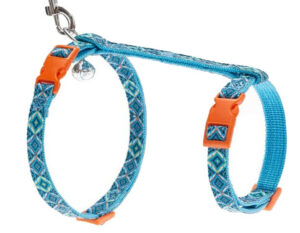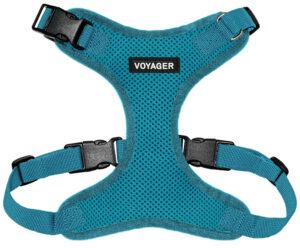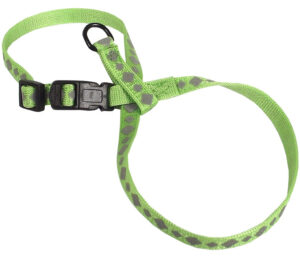Don’t be a scaredy-cat: Here’s how to put a harness on a cat!
How to put a harness on a cat?
Putting a harness on a cat is easy once your fur baby has been acclimated to it. The most common style has a quick release buckle/or loop to slip around the head and neck, and a second strap with a quick release buckle to go around the body and belly. There are multiple styles of cat harnesses to choose from so read on and let’s see which one best suits your feline companion.
Types of harnesses
H-style harness
This is what’s called an H-style cat harness.
When it’s opened and laying flat it has the shape of an H.
To put this cat harness on, you first clip the smaller strap around the base of your cat’s neck. Then clip the larger strap around the belly.
They are generally made using flat woven nylon fabric, with plastic or metal quick-release clips. Using woven nylon allows the harness to come in a rainbow of colors, with unlimited design patterns.
Look for unique boutique designers and you can get harnesses that are blinged out, monogrammed, or even bedazzled. Anything is possible, so find the perfect harness to fit both you and your cat’s personality.
Step in harness
Here is a step in harness.
It’s like a hybrid H-style cat harness, with the longer backstrap, but the main difference is the larger cushioned pad that goes from the belly, between the front legs, and up to the chest of your cat. These harnesses are more comfortable and harder for a cat to get out of.
To put it on, place it on the ground with 2 of the clips opened. Have your cat step over the pad, with it between the front legs, then clip the straps around your cat’s chest and belly.
Depending on the designer and manufacturer they will come in any number of colors and designs.
Figure 8 harness
As you can see this cat harness looks like the number 8 when it’s laid out.
These have one clip, and to put it on, start by putting the smaller loop around your cat’s neck and chest. Then clip the other loop around the belly.
Just like the H harness, these can be made from flat woven nylon as well as woven nylon cord.
Name a color and you can find a harness that matches. Any number of design patterns can be found, it all comes down to the designer or manufacturer.
Vest style harness
Last but not least is the vest-style cat harness.
Generally considered the most secure harness, they are padded harnesses that literally resemble a sleeveless cat t-shirt (if cats wore t-shirts!).
They don’t usually have any clips to secure them on your cat but use velcro instead.
To put it on open it up, put your cat’s front paws through the paw/sleeve holes, and secure the velcro around your cat’s back.
Colors, designs, and bling are limited only to the designer’s imagination.
How to choose the right size harness for your cat
There are a variety of styles of harnesses to choose from, so it is important to choose the right size for your cat.
If it’s too big the harness will be loose and could allow your cat to slip out. While too small of a harness will be tight and restrict your cat’s movement.
So let’s look at how to measure your cat to get the best fit.
Start by measuring the base of your cat’s neck, followed by the chest right behind the front legs. Take your measurements and check them on the size chart for the harness.
When in doubt always consult the directions provided by the manufacturer.
How long does it take for a cat to get used to a harness
There is not a specific answer to this question since there are a variety of factors to consider.
These include your cat’s age, temperament, and any prior experiences he or she may have had with harnesses or being restrained.
However, in general, it takes most cats a few days to a couple of weeks o get adjusted to wearing a harness and feel comfortable with it.
During this time, it is important to be patient and properly introduce your fur baby to the harness using positive reinforcement techniques such as treats or praise.
How to put a harness on a cat
Introduction
When introducing a harness to your cat for the first time you need him/her to get comfortable with it.
Gradually incorporating the harness into your daily routine will help your cat not to fear the harness.
This is done by leaving the harness among your cat’s toys and keeping it in an area where you play with your cat. While eating, leave it near the food bowl.
You want your baby to see and associate the harnesses as just another positive experience.
Getting the Harness On
Start by putting the harness on your cat.
Don’t be surprised if he/she has a fit or a tantrum or just flops down on their side and acts like gravity just multiplied tenfold.
Wait about a min or two, then give your baby a treat, some praise, morale support, then take the harness off. That’s it for the day. Tomorrow, do the same thing but leave the harness one for a little longer. Give the treats, praise, and support.
Rinse and repeat every day, each day increasing the time you leave the harness on.
Always remember to give positive reinforcement as this can be stressful to some cats. You always want a positive association, not negative, with the harness.
This is where your patience really comes into play, as there is no specific time frame to when your cat will get comfortable with the harness. Take your time, it’s totally up to your fur baby now.
Attaching the leash
Once your fur baby has gotten accustomed to wearing their harness and is not bothered by wearing it, it’s time to add a leash to the equation.
Like you did with the harness attach your leash to the harness and let your baby run around the house with it attached to the harness.
Again start with the leash attached for a min. Give treats, praise, and support. Take it off.
The next day do it again leave it on longer, give treats, praise, and support. You get the idea.
You are giving your cat the time it needs to get accustomed to the added weight of the leash.
Take as long as needed until the leash doesn’t bother your cat anymore.
Starting the Walk
Now before you head out the door and bring yer little buddy out into the big wide world, you need to get him/her used to walking with you.
With the harness on and leash attached, hold the leash and start following your cat around the house.
Gently guide your cat in a different direction.
As always give treats, and praise when they follow your lead.
Your First Outing
Now it’s time to show your fur baby the big wide world.
Introduce your cat to the great outdoors in the same manner as you’ve done with the previous steps, by taking it easy and at their pace.
Start by going into your backyard or front yard. If you live in an apartment find a quiet area with no dogs for your first trip.
Remember little steps at a time your cat will let you know if they are getting scared or in sensory overload.
If your cat freezes up, panics, or gets scared during your first outing, go back inside and try again tomorrow.
Remember to go at your cat’s pace, and don’t force them, it’s supposed to be a fun positive experience.
In conclusion
Putting a harness on a cat can be a great way to keep them safe when they’re out and about.
There are different types of harnesses available, so it’s important to choose the right one for your cat.
It may take a little time for your cat to get used to wearing a harness, but with patience and persistence, you can get them comfortable with it.
Soon you and your four-legged child will be enjoying many adventures and walks outdoors.



